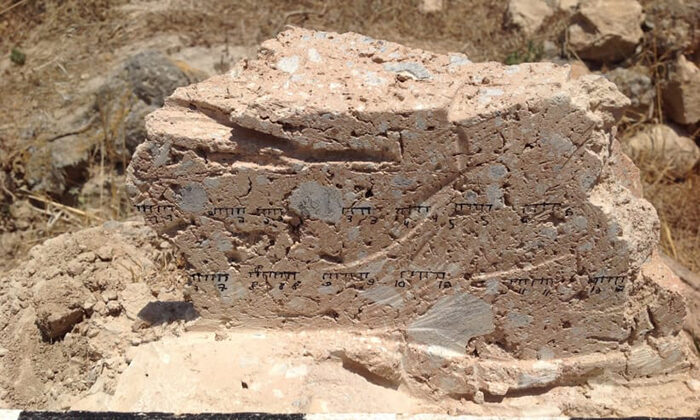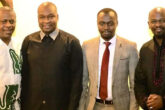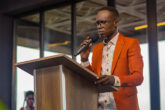
One of the studied burnt mudbricks.(photo credit: Dr. Yoav Vaknin)
In a groundbreaking discovery, researchers from four Israeli universities, including Tel Aviv University (TAU) and the Hebrew University of Jerusalem (HU), have employed a revolutionary technology to affirm an event documented in the book of 2 Kings.
This innovative method, based on measuring the magnetic field recorded in burnt bricks, offers new insights into the conquest of the Philistine city of Gath by Hazael, King of Aram.
Biblical Corroboration
The research, detailed in the journal PLOS ONE, validates the biblical account: “About this time, Hazael, King of Aram, went up and attacked Gath and captured it. Then he turned to attack Jerusalem,” (2 Kings 12:18). By examining burnt materials in ancient Gath, the largest city of its time, the multidisciplinary team of scientists has shed light on the intensity of the fire and the extent of destruction during this historical event.
“Our findings are important for determining the intensity of the fire and the scope of destruction in Gath—the largest and most powerful city in the land at the time—and also for understanding construction practices in the region,” the researchers wrote. “Applying thermal demagnetization to archaeological materials: A tool for detecting burnt clay and estimating its firing temperature.”
Technological Breakthrough
The researchers’ method, known as thermal demagnetization, surpasses previous techniques by determining whether items like mud bricks underwent firing even at relatively low temperatures, crucial for accurate archaeological interpretation. This technique traces its roots back to the biblical era, as mentioned in the book of Genesis during the story of the Tower of Babel (Gen. 11:3).
Magnetic Field Analysis
Dr. Yoav Vaknin, leading the study, explained the method’s reliance on measuring the magnetic field recorded in burnt bricks. As bricks burn, ferromagnetic particles align with the Earth’s magnetic field, creating a strong and uniformly oriented magnetic field in the cooled-down brick. The team gradually erased this field using thermal demagnetization, affirming the method’s validity.
“In a sun-dried mud brick, the orientation of these magnets is almost random so that they cancel out one another. Therefore, the overall magnetic signal of the brick is weak and not uniform. Heating to 200°C or more, as happens in a fire, releases the magnetic signals of these magnetic particles and, statistically, they tend to align with the earth’s magnetic field at that specific time and place. When the brick cools down, these magnetic signals remain locked in their new position, and the brick develops a strong and uniformly oriented magnetic field that can be measured with a magnetometer. This is a clear indication that the brick has, in fact, been fired,” Vaknin explains.
Sensitivity and Accuracy
The sensitivity of this new technique allows the identification of burning at much lower temperatures than previous methods. “Most techniques used for identifying burnt bricks are based on actual changes in the minerals that usually occur at temperatures higher than 500°C, when some minerals are converted into others,” said Dr. Adi Eliyahu Behar. Their method begins detecting changes at temperatures as low as 100°C, providing conclusive findings from 200°C and upward.
Archaeological Dispute Resolution
Applying their method to an archaeological dispute at Tell es-Safi, identified as the Philistine city of Gath, the researchers confirmed that the bricks burned and cooled in-situ during a single conflagration event. This conclusion contradicted the hypothesis that the structure collapsed over time, supporting the biblical account of Gath’s destruction by Hazael.
“Had the bricks been fired in a kiln and then laid in the wall, their magnetic orientations would have been random. Moreover, had the structure collapsed over time, not in a single fire event, the collapsed debris would have displayed random magnetic orientations. We believe that the main reason for our colleagues’ mistaken interpretation was their inability to identify burning at temperatures below 500°C. Since heat rises, materials at the bottom of the building burned at relatively low temperatures, below 400°C, and consequently the former study did not identify them as burnt leading to the conclusion that the building had not been destroyed by fire,” says Vaknin.
Ecological Implications and Historical Significance
Beyond its historical and archaeological significance, the researchers emphasized the ecological implications of ancient building methods. Brick-firing technology, requiring substantial combustive materials, might have led to deforestation and ecological shifts in the region. The findings suggest that such technology might not have been practiced in the Land of Israel during the times of the kings of Judah and Israel.
Inerrancy of the Bible
As we delve into these archeological revelations, it’s essential to highlight the inerrancy of the Bible. The Scriptures, the inspired Word of God, continue to withstand the test of time and archaeological scrutiny. The accuracy of biblical accounts, as validated by technological advancements, reinforces our faith in the authenticity and reliability of God’s Word.
The recent archeological breakthrough not only confirms the historical events documented in the Bible but also showcases the meticulous care with which God’s Word has been preserved. As technology advances and researchers unearth more evidence, the inerrancy of the Bible remains unshaken. These discoveries serve as a testament to the enduring truth and reliability of the Scriptures, inviting us to explore the depths of our faith with renewed confidence.

